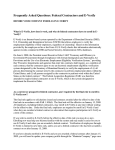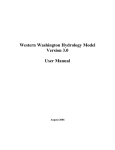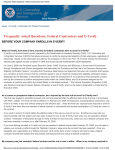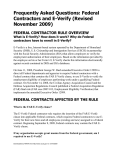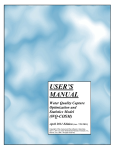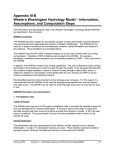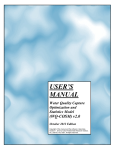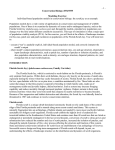Download UDFCD Stormwater Legislation Memo
Transcript
MEMORANDUM FROM: Ken MacKenzie, P.E. Master Planning Program Manager SUBJECT: New Colorado Revised Statute §37-92-602 (8) “Concerning a Determination that Water Detention Facilities Designed to Mitigate the Adverse Effects of Storm Water Runoff Do Not Materially Injure Water Rights.” DATE: Updated October 15, 2015 (Original July 7, 2015) Senate Bill 15-212 was signed into law by Governor Hickenlooper in May 2015 and became effective on August 5, 2015 as Colorado Revised Statute (CRS) §37-92-602 (8). This statute provides legal protection for any regional or individual site stormwater detention and infiltration facility in Colorado, provided the facility meets the following criteria: 1. It is owned or operated by a governmental entity or is subject to oversight by a governmental entity (e.g., required under an MS4 permit) 2. It continuously releases or infiltrates at least 97% of all of the runoff from a rainfall event that is less than or equal to a 5-year storm within 72 hours after the end of the event 3. It continuously releases or infiltrates as quickly as practicable, but in all cases releases or infiltrates at least 99% of the runoff within 120 hours after the end of events greater than a 5-year storm 4. It operates passively and does not subject the stormwater runoff to any active treatment process (e.g., coagulation, flocculation, disinfection, etc.) 5. If it is in the Fountain Creek (tributary to the Arkansas River) watershed it must be required by or operated in compliance with an MS4 permit The statute specifies that runoff treated in stormwater detention and infiltration facilities shall not be used for any other purpose by the owner/operator/overseer (or that entity’s assignees), shall not be released for subsequent diversion or storage by the owner/operator/overseer (or that entity’s assignees), and shall not be the basis for a water right or credit. plan\ken\CRS 37-92-602(8) memo update 20151015 There are specific notification requirements that apply to all new stormwater detention and infiltration facilities, including individual site facilities built by private parties as a development requirement. For any stormwater detention and infiltration facility constructed after August 5, 2015 and seeking protection under the new statute, the “entity that owns, operates, or has oversight for” shall, prior to operation of the facility, provide notice to all parties on the substitute water supply plan notification email list maintained by the State Engineer. This notice must include the following: 1. The location 2. The approximate surface area at design volume 3. Data that demonstrates that the facility has been designed to comply with the release rates described in Items 2 and 3 above The Colorado Division of Water Resources (DWR) maintains seven email lists, one for each of the seven major watersheds in Colorado (these coincide with the seven DWR Divisions). UDFCD worked with DWR and the Colorado Stormwater Council to develop a simple data sheet and an online map-based compliance portal website that will allow all municipalities and counties in Colorado to easily upload this required notification information. The website application will then automatically send email notifications to the proper recipients, relieving public works staff of the emailing burden while also minimizing the volume of email going out to the email list recipients. Please note that the notification requirement applies only to new stormwater facilities (constructed after August 5, 2015), which the statute provides a “rebuttable presumption” of noninjury to water rights. This rebuttable presumption is contestable but only by comparison to the runoff that would have been generated from the undeveloped land condition prior to the development necessitating the stormwater facility. Stormwater facilities in existence before August 5, 2015 are defined in the statute as materially non-injurious to water rights and do not require notification. The compliance portal can be found here: https://maperture.digitaldataservices.com/gvh/?viewer=cswdif A tutorial YouTube video can also be accessed from that website or found here: https://www.youtube.com/watch?v=4yg0hyk8fDw We also have a list of frequently asked questions with answers which is attached to this memorandum. Please email me at [email protected] with any questions. plan\ken\CRS 37-92-602(8) memo update 20151015 Colorado Revised Statute 37-92-602(8) Frequently Asked Questions First, some information about the compliance portal: https://maperture.digitaldataservices.com/gvh/?viewer=cswdif The compliance portal was developed to streamline the notification requirement of the new statute. Anyone can place a pin on the map to create a new stormwater detention/infiltration facility. The portal recognizes counties, cities, and towns as “jurisdictions” and has assigned to each jurisdiction administrative privileges. Jurisdictions can create, modify, or delete any record within their own jurisdiction, and must accept into the database a record created by anyone else within their jurisdiction. When a jurisdiction creates a new record it is automatically accepted into the database and its information is put into the queue for the email notification. The icon on the map interface will be blue. When anyone who is not a jurisdiction creates a new record in the portal database, the icon will remain green and no notification will go out until the jurisdiction accepts the record into the database which will turn the icon blue and place it in the queue for notification. The entity creating a record will be able to later edit that record using the edit password emailed to them by the portal. The password is specific to the record. Note that the jurisdiction accepting the record does not indicate approval of the facility, it is simply a necessary database quality assurance measure to prevent vandalism and errant records. If the jurisdiction believes the record to be in this class, they may delete the record or contact the creator of the record to verify it. If a record is not accepted or deleted by the jurisdiction with 30 days of its creation, it will automatically be accepted by the system, turn blue, and notifications will go out within a week of that event. Records are perpetually viewable by those with administrative privileges but are removed from the map 30 days after being accepted into the database. CSR 37-92-602(8) FAQ UDFCD 2015-08-26 Where is the compliance portal? https://maperture.digitaldataservices.com/gvh/?viewer=cswdif Is there a user manual for the operation of the statewide notification compliance portal? Will you please make a recording of the webinars available? The webinars were intended to give those in a position to create records and for those who will administer those records within their communities enough information to use the statewide notification compliance portal. A recording of the 7/30/2015 2 pm webinar is available on YouTube at: https://www.youtube.com/watch?v=4yg0hyk8fDw Where can I found out more information on the statute? A memorandum can be found under “Recent News” at http://www.udfcd.org/index.html Do existing facilities need to be entered? No. If the facility is already operable on August 5, 2015, notification is not required. These facilities are defined in the statute as non-injurious to water rights, provided they meet the other criteria specified in the statute. Does this statute apply only to facilities within MS4s or government owned facilities? A private facility located in a rural area would not need to be uploaded? The statute protects only those stormwater detention and infiltration facilities that are operated solely for stormwater management and are owned or operated by a governmental entity or are subject to oversight by a governmental entity (e.g., required under other statutes for flood protection or water quality). Additionally, to be covered, these facilities must meet the drain time limitations and other criteria specified in the statute and UDFCD memorandum. If a hypothetical private facility located in a rural area was voluntarily built (not as an imposed development requirement), it is not protected under the statute and no notification is required, but it may be considered a water diversion out of priority by the State. Does the design engineer upload the notification or does the government entity with jurisdiction (MS4) upload it? Who is the “applicant?” Would it be the City or the property owner? Either way will work. The land developers and nonstandard MS4s within the cities, towns, and counties of Colorado will have editorial privileges necessary to create, modify, and delete only their own records. The cities, towns, and counties of Colorado will have administrative privileges to create, modify or delete any record within their jurisdiction. This is to allow those jurisdictions to monitor for malicious or errant activity. Those with administrative privileges will also receive an email immediately whenever a record is created, modified, or deleted within their jurisdiction. For the location - do we need to input an address, a latitude and longitude, what are the criteria to get it in the right place? The map feature offers a number of ways to zoom to the correct location, including "zoom to address" and "zoom to map." Any of these methods should enable you to place a marker within 100 feet of the exact location. This meets the intent of the notification requirement. Once you place the pin, the latitude, longitude, DWR division, and local jurisdiction will all be automatically populated in the database. CSR 37-92-602(8) FAQ UDFCD 2015-08-26 Why is Fountain Creek excluded from legislation and what do you need to do if you build a detention/WQ basin in the Fountain Creek watershed? Do you have to acquire water rights for them? Facilities in Fountain Creek that meet the other criteria specified in the statute are protected only if they are required by or operated in compliance with a Colorado-issued MS4 permit. Those facilities in the Fountain Creek watershed that do not meet this criterion are more susceptible to a claim of water right injury since that claim is not required to compare to the hydrologic condition of the watershed at the water right’s priority date, but they do not otherwise require a water right. The exclusion of the Fountain Creek watershed was a necessary concession in order to get the backing of the Colorado Farm Bureau, without which we would have no legislation. How do you prevent duplicate entries? What if two separate entities report compliance for the same facility. Is that OK? The map interface feature should eliminate this problem. When placing a marker icon, if there is already a marker icon at your location, click on that icon to retrieve the specific data for comparison. The local government will receive an email notice immediately whenever a new record is created within their jurisdiction. It’s not terrible if a duplicate shows up, but we should all be on the lookout for that. How should retention facilities be handled? Neither retention facilities nor constructed wetlands are protected under 37-92-602(8) CRS. These facilities expressly require a water right. Is there a backup of the site's data somewhere? One rogue developer could theoretically delete all ponds entered. The site has robust security features and automatic backups are produced and stored offsite at regular frequent time intervals. After notification, if a downstream water right user objects, what then? The downstream user can't object to a facility before it is operable but they can rebut the presumption of non-injury if they can prove they have been (not will be) injured after the facility is in place (and only then in respect to water they would have received at their priority date). We have facilities that protect areas less than one acre. Are they subject to this legislation? Yes. There is no size threshold for the notification requirement. All stormwater detention and infiltration facilities that meet the definition in the statute and are made operable after August 5, 2015 are subject to the statute. What type of feedback do you expect to get from the people you email? Each record created will have two email addresses, one for the record creator and one for the community having jurisdiction over the site. You may anticipate inquiries as to the need for the facility and details about how it operates. Would it be acceptable to notify at the time of plan approval and prior to construction? Yes, as long as notification occurs before the facility becomes operable, you are in compliance with the statute. CSR 37-92-602(8) FAQ UDFCD 2015-08-26 If a detention facility is below grade, is that apparent to users of the portal? Is water surface area needed? The statute applies to facilities above and below grade, and there is no requirement to distinguish which type the facility is. The water surface at design volume is one of three pieces of information mandated under the statute’s notification requirement. Do not enter zero for this value; instead enter the area of the vault. In the case of redevelopment, is the calculation from the existing developed condition to the proposed developed condition or from the assumed “predeveloped condition”? Any challenge must be with respect to the water the plaintiff would have received in the watershed condition that existed as of the water right's priority date, absent the urbanization necessitating the facility. Will this be emailed out in the monthly “resume” that the State Engineers office puts out, or as an individual email? A weekly digest email will be sent out to the recipients in each of the DWR's seven divisions. Each division will receive an email on a different day of the week to minimize traffic loading on the compliance portal. Will the weekly digest email contain all of the facilities, or just the new ones? Only those posted since the previous email will be included. Additionally, those facilities in existence for more than 90 days will no longer be visible to the general audience, only to those with editorial or administrative privileges. This is to reduce clutter on the portal and ease navigation for the end user. Could water rights users contest a facility even without any real basis just to tie up a development or make it more difficult to develop a property? What ability do irrigation companies, farmers, etc. have to impact a project when these notices go out? The water rights holder must show that the facility has caused injury (not will cause injury). The injury must be further with respect to the water the complainant would have received in the watershed condition that existed as of the water right's priority date, absent the urbanization necessitating the facility. What about regional facilities that are designed for the full build-out condition but operate in an interim mode that does not comply with the statute? Those constructed after August 5, 2015 should be designed to comply with the statute in their interim condition as well as in the final configuration. If they do not comply, they will not be protected under the statute, and no notification is required. Those already in operation on August 5, 2015 do not require notification, but are not protected unless they comply with the drain time criteria. Why do I have to print a pdf to upload, and not just upload my spreadsheet? Can't this feature be built into the portal? For reasons of consistency and storage limitations, the design data sheet can only be in pdf format. This also minimizes the risk of document altering by others. We would love to build it into the portal, but funding limitations currently prevent this. CSR 37-92-602(8) FAQ UDFCD 2015-08-26 Define “operational.” A detention and infiltration facility is operational when stormwater is flowing into it and flowing out of it (either on the surface or infiltrating into the soil below it), while experiencing a change in the detained volume over time (first increasing in volume and then decreasing). We often use detention and infiltration facilities as sedimentation basins in a modified temporary form during construction, and then finish them in their final designed form. Under these conditions, when do we provide notification? The statute states that the notification must happen before the facility becomes operable. This can be interpreted to mean operable in its final configuration. If you are using the facility in a modified and temporary form during construction of the larger site, you should wait until the final detention/infiltration configuration is complete before entering the record. Does the bill require that operation and maintenance demonstrate on-going compliance? What happens if a facility does not function as designed (e.g., lack of maintenance, poor infiltration, dead rain garden)? The statute protects only those facilities that meet the drain time criteria. If a facility does not operate as designed, or if the design proves to be flawed, not only is it not protected under 37-92-602(8) CRS, it also likely violates a CDPS-issued permit and corrective measures are responsibly warranted. Does notification need to take place for modifications to existing detention/water quality ponds? If the facility is already operable on August 5, 2015, it is defined in the statute as non-injurious to water rights, provided it meets the other drain time criteria specified in the statute. If your modifications are going to make the downstream water rights holders condition better (e.g., smaller stored volume or faster drain time), then no notification is required. If the opposite is true, handle it as a new facility and provide notification of the new configuration. Will existing facilities need to be retrofitted to meet the 72/120 hour drain time requirement? If your existing facility was designed to drain the water quality volume in 40 hours and to control the 10- and 100-year peak flow rates (the most common condition for 3-stage detention pre “full spectrum detention”) your facility almost undoubtedly meets the compliance criteria. If your existing facility is a retention pond and you don’t have a water right, then yes, you should retrofit (or get a water right). Can we route our own inflow hydrographs through the spreadsheet to show compliance? Yes, there is a table off to the right of the printable area that allows you to input your own storm hydrographs. In fact, this will be necessary for unusually large watersheds as the largest embedded inflow storm hydrograph in the workbook is 675.56 acre-feet in volume (the smallest is 0.001 acre-feet). The workbook has been tested successfully for watersheds as small as 0.1 acres in area. CSR 37-92-602(8) FAQ UDFCD 2015-08-26 The statute says “no other beneficial use” is allowed. Define "beneficial." As a municipal corporation, ponds are beneficial to us to keep pipe sizes smaller. Beneficial use refers to uses for which you would otherwise need a water right, like replacement water or irrigation water. Are State agencies and RTD to be given usernames and passwords? Those agencies will be treated in the same manner as land developers and nonstandard MS4s within the cities, towns, and counties of Colorado, and will have editorial privileges necessary to create, modify, and delete only their own records. The cities, towns, and counties of Colorado will have administrative privileges to create, modify or delete any record within their jurisdiction. How do these new regulations apply to micropool designs since they typically will exceed the 120 hour release time period? The volume of the micropool is typically 0.0006 times the 5-year inflow volume (0.06%) and 0.0002 times the 100-year inflow volume (0.02%), so is well within the allowable criteria. Micropool reduce the prevalence of mosquitos with respect to the “no-micropool” condition by replacing the soggy area of frequent inundation with a small and deep pool which is much less conducive to mosquito egg survival, and also by creating habitat for predator species (e.g., dragon flies). Who will be auditing the statewide notification compliance portal for correct data? There is no statutory enforcement mechanism, so the process will be mostly self-policed. Those communities having administrative privileges will receive an email notice every time a record is created, edited, or deleted within their jurisdiction and should review these records for accuracy. The DWR does react to complaints. If the community uploads the data for the developers, does it appear that the community is the owner? Each record will have two contact email addresses as part of the public record, one for the engineer of record and one for the community having jurisdiction over the facility. In the design data spreadsheet do we use the 60-minute 1-year storm value (at basin location) for the WQCV Design Storm amount? And is the water quality capture volume drainage time a maximum or minimum of 40 hours? The Urban Storm Drainage Criteria Manual Vol. 3, Chap. 3 (http://www.udfcd.org/index.html) gives detailed information on sizing the water quality capture volume anywhere in Colorado and guidance on recommended drain times (e.g., 40 hours for extended detention, 12 hours for rain gardens). If you have several water qualityonly facilities on one site, do you report each one separately or all of the facilities for one site? For example 4 rain gardens in a grocery store parking lot - 4 sites on the notification map or 1? If these facilities are intended for water quality only and the all operate in a similar manner (e.g., all rain gardens with similar drain times and operation), they may be aggregated and reported as one facility (with one cumulative water surface at design volume). CSR 37-92-602(8) FAQ UDFCD 2015-08-26 What types of facilities are and are not covered under this legislation? See the tables below for a partial list of facilities covered under and excluded from 37-92-602(8) CRS. Statute applies to these (from USDCM): Statute does not apply to these (from USDCM): Rain Gardens Grass Buffers (no water right required) Extended Detention Basins Grass Swales (no water right required) Sand Filters Retention Ponds (requires a water right or water purchase) Permeable Pavement Systems Constructed Wetland Ponds (requires a water right or water purchase) Full Spectrum Detention Basins Constructed Wetland Channels (may require water right / purchase if in-channel detention is used) Statute applies to these (not in USDCM): Statute does not apply to these (not in USDCM): All other flood control detention basins Flow through devices (Stormceptors and other hydrodynamic separators, baffle vaults w/o storage) Underground detention vaults that hold back a volume of stormwater and meter its release (including underground sand filters) with or without pumping. Process water holding ponds for the oil and gas industry Stock ponds and irrigation ponds Sediment traps Any facility not meeting the following criteria: (a) is owned or operated by a governmental entity or is subject to oversight by a governmental entity; (b) continuously releases or infiltrates at least 97% of the 5-year storm within 72-hours; (c) continuously releases or infiltrates at least 99% of the 100-year storm within 120-hours; (d) operates passively and does not subject the stormwater runoff to any active treatment process. CSR 37-92-602(8) FAQ UDFCD 2015-08-26









